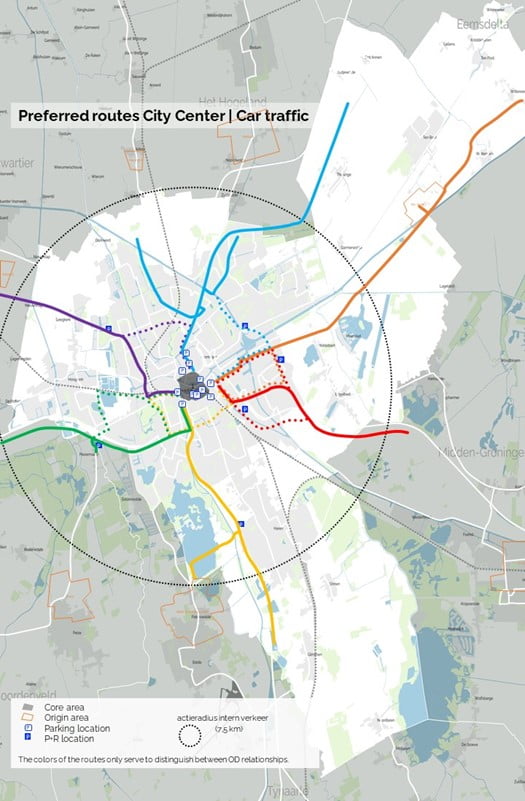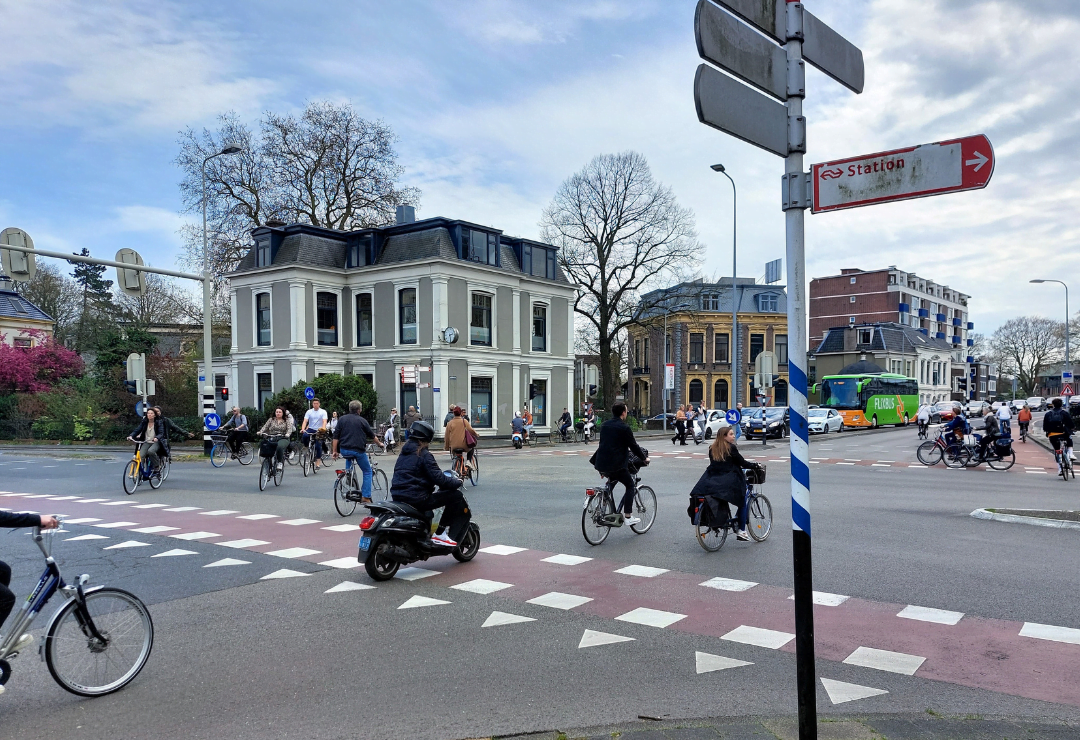Managing a Multimodal Groningen
The city of Groningen has a tradition of progressive mobility policy, which focuses on a healthy living environment and changing travel behaviour. With new frameworks for multimodal traffic management, Groningen is now also making the priority on paper for walking, cycling and public transport visible on the street.

More space for pedestrians and cyclists in the Brugstraat in Groningen. Credit: Terry Albronda
As a further elaboration of Groningen's Sustainable Urban Mobility Plan (SUMP) ‘Groningen Well on the Way’ (2021), the preferred position of pedestrians and cyclists has been made concrete at the system level and brought into line with the interests of other modalities. Groningen laid this down in the Multimodal Network Framework Groningen (2023), a living document that maps out the preferred routes for traffic to and from the most important destinations within the city.
Subsequently, in a Traffic Lights Policy Plan (2023), the political choice to give more attention and priority to walking, cycling, and public transport was translated into ambitious short waiting times at traffic lights. With the Multimodal Network Framework and the Traffic Lights Policy Plan, Groningen has unique guidelines available to actively manage urban accessibility and quality of life.
Framework for regulating urban accessibility
To make better, or different, use of the existing infrastructure, a framework is needed to make well-founded choices. Groningen, therefore, has translated its SUMP ambitions into a guideline for urban accessibility; the Multimodal Network Framework Groningen (MNF). In the MNF the modalities of walking, cycling, public transport, and (freight) car traffic are integrally included so that all modalities can be viewed in conjunction.

Function profiles for car traffic. Credit: City of Groningen
The municipality of Groningen has identified the most important destinations and mapped out preferred routes for traffic to and from those destinations in the multimodal network framework (MNF). The MNF prioritises handling traffic on these routes as much as possible.
Subsequently, the desired quality in terms of accessibility, quality of life, and road safety is determined for the roads and paths on which the (preferred) routes run. Because the desired quality does not have to be the same level everywhere, the roads and paths are assigned a specific function (function profile).
A function profile describes, among other things, which type of relationship and which type of user is facilitated. The result is ultimately a multimodal functional map, the aim of which is to have each road section function as described in the function profile.
When designing and implementing traffic management measures, choices have to be made constantly between the importance of the modalities on a route.
If, for example, there are too many delays for public transport due to crowds, or if the safety of a bicycle crossing can no longer be guaranteed, measures are taken to solve or alleviate these bottlenecks. The order of priority from the MNF applies to the deployment of these measures. This is based on the principle that within the city borders emergency services are given the highest priority, followed by main streams for pedestrians and bicycles, then public transport and finally the car.
The desired functioning of the multimodal network is quantified in a multimodal policy frame of reference. By elaborating indicators with target values for the function profiles of the individual modalities, the traffic situation can be periodically monitored and set against the desired situation, as a result of which (trends in) bottlenecks become visible.
Traffic lights as a control instrument
Within the city of Groningen, there are more than 60 municipal traffic lights. These are the ‘traffic management buttons’ that can be turned to make a direct and visible contribution to municipal mobility ambitions. To achieve this in a uniform and structured manner, simultaneously with the MNF, a framework for regulating multimodal policy objectives was also drawn up: the Traffic Lights Policy Plan Groningen.
Everywhere in the Netherlands, you will encounter traffic lights. These have been realised by national regulations that set a large number of mainly technical requirements for traffic lights. However, how, where and when traffic lights regulate traffic is not laid down in these national guidelines: they are based on choices that the municipality of Groningen must make itself. These choices have been made in the Traffic Lights Policy Plan and divided into four strategies:

Preferred routes to the city centre (cars). Credit: City of Groningen
- When traffic lights in Groningen are installed, replaced or removed (installation strategy);
- How the traffic lights contribute to the realisation of Groningen's mobility policy and with what measurable quality levels (control strategy);
- Based on which requirements and with which functionalities the traffic must be arranged (design strategy);
- How the traffic lights are maintained and how they are tested following the policy (maintenance strategy).
The Traffic Lights Policy Plan is an ambitious plan in which more attention to walking, cycling and public transport has been translated into short waiting times at traffic lights for the road users Groningen want to give priority to. It also offers possibilities to adapt to the inflow of car traffic on certain routes. It is accepted that car traffic will have to wait a little longer. Where the MNF translates the mobility ambitions to route and network level, the Traffic Lights Policy Plan gives direction to the objectives at the intersection level.
The preferred position of pedestrians and cyclists has been elaborated with the Multimodal Network Framework and Traffic Lights Policy Plan and brought into line with the interests of the other modalities. The impact of progressive quality levels at intersections can be significant. It will become clear that there is not only the ‘sweet’ of more space for pedestrians and bicycles, but also the ‘sour’ of less space for car use.
The fine art of multimodal traffic management
Getting a grip on urban accessibility is possible through smart management of multimodal traffic flows. Multimodal network frameworks, the use of intelligent traffic lights, and data-driven work play an important role in this. In the end, it is all about the effects that we make visible and experience on the street.
Click here to read the article in its original format.
About the author:
Terry Albronda is a Smart Mobility Policy Advisor for the City of Groningen. He has been working on mobility issues for over 25 years, first as a consultant and, since 2011, as a policy developer for traffic management and smart mobility in Groningen. Terry is committed to knowledge development and innovation and coordinates and stimulates (inter)national cooperation on urban mobility.
